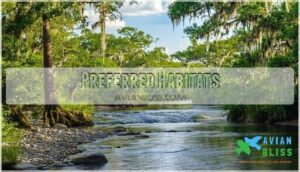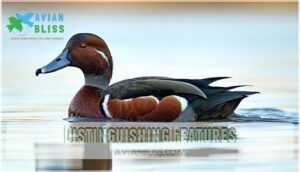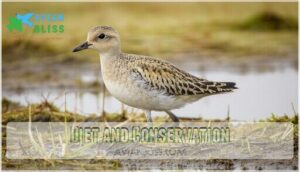This site is supported by our readers. We may earn a commission, at no cost to you, if you purchase through links.
 You’ll recognize the American golden plover by its stunning transformation from speckled gold breeding colors to muted gray-brown winter plumage.
You’ll recognize the American golden plover by its stunning transformation from speckled gold breeding colors to muted gray-brown winter plumage.
This remarkable shorebird completes one of nature’s most incredible journeys, flying up to 25,000 miles annually between Arctic tundra and South American grasslands.
Unlike typical beach plovers, you’ll spot these hardy travelers in prairies, agricultural fields, and short-grass habitats across North America’s interior during migration.
They’re built for endurance, capable of nonstop 88-hour flights over open ocean while traversing between Alaska’s breeding grounds and Argentina’s pampas.
Their distinctive black belly patch and golden-speckled back make identification straightforward during breeding season, though separating them from Pacific golden plovers requires knowing specific field marks that experienced birders swear by.
Table Of Contents
- Key Takeaways
- American Golden Plover
- Habitat and Distribution
- Behavioral Traits
- Taxonomy and Identification
- Diet and Conservation
- Frequently Asked Questions (FAQs)
- What is the difference between golden plover and American Golden-Plover?
- What was the most amazing fact about the golden plover?
- Where does the American Golden-Plover live?
- How far does the American Golden-Plover migrate?
- What is the difference between golden-plover and American Golden-Plover?
- Is the golden-plover the fastest bird?
- What was the most amazing fact about the golden-plover?
- How did the American Golden-Plover get its name?
- How long do American Golden-Plovers typically live?
- Do they have any natural predators?
- Conclusion
Key Takeaways
- You’ll recognize the American Golden Plover by its golden-speckled back and dramatic shift from bold breeding colors to muted winter tones.
- You’ll witness one of the world’s longest bird migrations, with these plovers flying up to 25,000 miles annually between the Arctic and South America.
- You won’t just find them on beaches; they prefer prairies, fields, and grasslands during migration, showing real adaptability.
- You can spot them by their slender build, black belly patch in breeding season, and distinct run-stop-peck foraging behavior.
American Golden Plover
The American Golden Plover is a medium-sized shorebird that makes one of the longest migrations in the bird world, traveling over 40,000 kilometers annually between Arctic breeding grounds and South American wintering areas.
You’ll recognize this elegant plover by its slender build, narrow bill, and distinctive seasonal plumage changes that transform it from a striking black-and-gold breeding bird to a subdued grayish traveler.
Physical Characteristics
When you spot an American Golden Plover, you’ll notice its distinctive teardrop-shaped body and trim build.
This medium-sized shorebird showcases a relatively large head, slim neck, and short, slender bill that’s perfectly straight.
The bird’s long, pointed wings and relatively long legs give it an elegant appearance that sets it apart from other plovers in the field.
These birds undertake impressive migratory journeys from the Arctic to South America, which is a notable aspect of their migratory behavior and overall elegant appearance.
Size and Weight
You’ll find the American Golden Plover measures 24-28 cm in length with a 65-67 cm wingspan.
They belong to the Charadriidae family, a group that includes plovers, dotterels, and lapwings.
These birds weigh between 122-194 grams, averaging around 145 grams.
There’s no sexual dimorphism in size – males and females share identical average dimensions.
Their compact build makes them larger than robins but smaller than crows, with measurement techniques focusing on bill shape and overall proportions for accurate bird size comparison.
Breeding and Non-breeding Plumage
American golden plover plumage changes dramatically between seasons.
Breeding plumage shows bold black underparts with gold-spangled wings and a white neck stripe. Nonbreeding plumage appears gray-brown with pale undersides and a whitish eyebrow.
These seasonal colors help identify the bird year-round. The vibrant plumage contrasts with other birds, such as the Scarlet Macaw’s rainbow colors.
Plumage Variations by Season and Age:
- Breeding males – Solid black belly and face with crisp white markings
- Breeding females – Mottled black underparts, less distinct than males
- Nonbreeding adults – Gray-brown above, pale below with faded eyebrow
- Juvenile plumage – Brownish-gray with yellow-white speckles, scaly-looking feathers
- Molting patterns – Spring molt into breeding colors, fall molt back to basic plumage
Habitat and Distribution
You’ll find American Golden Plovers in surprisingly diverse habitats throughout their remarkable journey from Arctic tundra to South American grasslands.
These adaptable shorebirds breed on dry, open tundra across Alaska and northern Canada, then migrate through central North America’s prairies, farm fields, and mudflats.
Before wintering in Argentina’s agricultural landscapes, they complete their migration, showcasing their ability to thrive in various environments, including agricultural landscapes.
Preferred Habitats
Throughout their remarkable journey, these golden plover habitat specialists choose distinctly different homes for each life stage.
Arctic tundra nesting occurs on dry, sparsely vegetated slopes across Alaska and northern Canada.
During migration stopovers, you’ll spot them in short-grass prairies, agricultural habitats, and open fields throughout central North America. Their habitat selection favors recently disturbed farmland and grazed pastures.
Wintering grounds encompass South American grasslands, where these adaptable grassland birds thrive in temperate meadows from Argentina to Brazil.
You can find products related to plover habitat maps online.
Geographic Range
This Arctic breeding shorebird spans from Baffin Island across northern Canada to Alaska’s tundra.
American GoldenPlover populations concentrate in these northern regions during summer months.
Migration routes stretch through eastern North America’s interior, while wintering grounds extend across southern South America’s grasslands.
Population distribution shows highest densities in Alaska, with remaining birds scattered throughout Canadian arctic breeding territories.
These birds, like others that inhabit the arctic tundra, have adapted to survive in cold, harsh environments, which is a critical aspect of their survival.
Migration Patterns
Crossing vast distances annually, you’ll witness one of nature’s most impressive journeys as American Golden-Plovers complete their elliptical migration exceeding 20,000 miles.
You’ll witness nature’s ultimate endurance test as these remarkable plovers traverse continents in a single, breathtaking journey.
These migratory birds showcase remarkable endurance during their epic travels.
You can find a migration tracking product to follow them.
- Transoceanic flights: Southbound migration routes cross 2,400 miles nonstop over the western Atlantic
- Stopover locations: Spring staging areas in Illinois and Tennessee concentrate thousands in single fields
- Flight altitudes: Nighttime migration occurs at elevations reaching 15,000 feet during transit
Behavioral Traits
You’ll observe distinct behavioral patterns that help identify American Golden Plovers in the field.
Their characteristic "run-stop-peck" foraging method and seasonal flocking behaviors make them fascinating birds to watch during migration periods, with their seasonal flocking behaviors being a notable aspect of their life cycle.
Foraging Habits
Like a feathered detective, you’ll spot American Golden Plovers using their signature run-stop-peck feeding behavior.
They dash forward, freeze to scan, then snatch prey.
Their seasonal diet shifts from tundra insects to grassland beetles during migration.
Watch for this habitat foraging pattern in fields and mudflats, where their prey selection includes crustaceans and mollusks, using their unique feeding behavior to catch crustaceans.
Flocking and Migration
Beyond their feeding patterns, you’ll witness these plovers’ incredible bird migration journeys. American Golden Plovers complete epic 20,000-mile round trips from arctic breeding birds territories to South America.
Their shorebird migration includes a breathtaking 3,500-mile nonstop Atlantic crossing, showcasing remarkable endurance in pluvialis dominica populations.
Migration highlights you’ll observe:
- Flight Altitude: Flocks soar up to 15,000 feet during nighttime migration, guided by stars
- Migration Timing: Adults depart Arctic grounds before juveniles, with females often leading the way
- Stopover Habitats: Large flocks gather in prairie fields, mudflats, and agricultural areas for refueling
- Flock Dynamics: Groups form loose, noisy congregations during migration, abandoning territorial behavior temporarily
Their Migration Routes follow an elliptical pattern – southbound over the Atlantic, northbound through central North America. This golden plover habitat strategy maximizes favorable winds and food availability across continents.
This behavior demonstrates safety in numbers, a key survival strategy.
Breeding and Nesting
After massive migrations, these arctic breeding birds settle into serious business on the tundra.
Males defend breeding territory spanning 25-125 acres through aggressive displays. They construct multiple tundra nests before selecting one, lining it with lichen and grass.
Both parents share incubation duties for 24-27 days.
| Breeding Aspect | Details |
|---|---|
| Clutch Size | Typically 4 eggs, olive-brown with dark spots |
| Chick Development | Precocial young leave nest within 24 hours |
| Parental Care | Both sexes incubate; males by day, females by night |
The plover bird’s nesting success depends heavily on timing and predator avoidance, with parents performing dramatic "broken wing" displays to protect their young.
Taxonomy and Identification
You’ll recognize the American Golden Plover by its scientific name Pluvialis dominica and its position within the Charadriidae family of shorebirds.
This medium-sized plover stands out from similar species through its slender build, narrow straight bill, and distinctive plumage patterns that change dramatically between seasons.
Taxonomic Classification
You’ll find the American Golden Plover classified under the scientific name Pluvialis dominica within the Family Charadriidae and Order Charadriiformes.
This avian taxonomy places it among true plovers in bird classification systems. The Genus Pluvialis, meaning "related to rain" in Latin, reflects historical observations of these birds flocking before storms.
Scientific nomenclature separated this species from Pacific and European golden plovers in the 1990s following genetic research that confirmed distinct breeding behaviors and calls. Modern classification relies on DNA sequencing methods to refine avian taxonomy.
Distinguishing Features
You’ll recognize Pluvialis dominica by several key features that set it apart from other shorebirds.
This medium-sized plover shows distinct characteristics that make field identification straightforward:
- Slender, straight bill – shorter than the head length
- Long, pointed wings – extending past the tail when folded
- Proportionally long legs – giving it an elegant stance
- Solid black underparts – from face to undertail in breeding plumage
- Prominent white eyebrow – contrasting with dark crown in all seasons
The bird’s sleek wing structure and bill shape distinguish it from bulkier plovers.
Size comparison shows it’s larger than a Killdeer but smaller than a Black-bellied Plover, with plumage details varying seasonally from striking black-and-gold breeding colors to subdued gray-brown winter tones.
Comparison With Similar Species
When you’re identifying American Golden-Plovers, you’ll encounter two tricky look-alikes that’ll test your field identification skills.
The Pacific Golden-Plover and Black-bellied Plover share similar habitats and behaviors, but key differences in bill morphology and plumage variations help separate these species.
| Feature | American Golden-Plover | Pacific Golden-Plover | Black-bellied Plover |
|---|---|---|---|
| Bill Size | Fine, straight, shorter than head | Similar but slightly longer | Thick, robust, longer |
| Breeding Underparts | Solid black from face to undertail | Black with white flank stripe | Black belly, white undertail |
| Underwing Color | Gray axillaries | Gray axillaries | Black "armpits" |
The Pacific GoldenPlover shows more yellow tones on its back and extends its white flank stripe further down.
Black-bellied Plovers are bulkier with distinctive black underwing patches that flash during flight, making bird species comparison straightforward once you know what to look for.
Diet and Conservation
You’ll discover that American Golden Plovers maintain a diverse diet that changes with the seasons and their incredible migration journey.
Understanding their feeding habits and conservation needs helps you appreciate these remarkable birds and the challenges they face across their vast range, which involves incredible migration.
Diet Composition
American Golden Plovers feast primarily on insects throughout their lifecycle.
You’ll observe these shorebirds consuming beetles, grasshoppers, flies, caterpillars, and spiders during breeding season.
Their plover diet shifts with seasonal variation – berries like crowberries become essential for pre-migration fat storage.
Dietary adaptations include prey selection based on habitat availability, and insect consumption meets their nutritional needs across diverse environments from Arctic tundra to agricultural fields.
Foraging Techniques
When you watch these plovers hunt, you’ll notice their signature Run-Stop-Peck method.
They sprint forward, freeze to scan for movement, then quickly grab prey from the ground.
This visual foraging technique works perfectly on mudflats and plowed fields where insects hide.
Their diet composition shifts seasonally – they’ll target different prey based on habitat availability and energy needs during migration.
Conservation Status and Threats
The IUCN classifies this species as "Least Concern," but don’t let that fool you.
Population trends show mixed results across regions, with habitat loss and climate change posing serious threats.
Pesticide use in agricultural areas where they forage creates additional risks.
Hunting pressure has decreased since historic market hunting nearly wiped them out.
Plover conservation efforts focus on protecting migration stopover sites and breeding grounds to maintain stable bird population trends.
Supporting these efforts may involve using specialized habitat tools to address the issue of climate change.
Frequently Asked Questions (FAQs)
What is the difference between golden plover and American Golden-Plover?
Golden plover is a general term for several plover species, while American Golden-Plover refers specifically to Pluvialis dominica.
You’ll find American Golden-Plovers distinguished by their slender build, narrow bill, and unique migration pattern through central North America to South American wintering grounds, which includes a notable migration pattern.
What was the most amazing fact about the golden plover?
You’ll be amazed that these birds complete a 40,000-kilometer annual migration – one of the longest journeys of any shorebird species on Earth.
Where does the American Golden-Plover live?
Like a nomadic wanderer following ancient pathways, you’ll find this plover breeds on Arctic tundra, migrates through central North America’s grasslands, and winters in South American agricultural fields.
How far does the American Golden-Plover migrate?
You’ll witness one of nature’s most impressive journeys as this bird completes an elliptical migration exceeding 40,000 kilometers annually, making it among the longest migrations of any shorebird species worldwide.
What is the difference between golden-plover and American Golden-Plover?
You’re comparing two similar-sounding names for the same bird species.
"Golden-plover" is simply a shortened, informal name for the American Golden-Plover (Pluvialis dominica).
They’re identical—just different ways to reference this Arctic-breeding shorebird.
Is the golden-plover the fastest bird?
No, the golden-plover isn’t the fastest bird.
The peregrine falcon holds that record, reaching diving speeds exceeding 200 mph.
You’ll find that golden-plovers are built for long-distance migration, not speed racing through the sky.
What was the most amazing fact about the golden-plover?
Migration mastery defines nature’s marathon champions. You’d be stunned learning these plovers complete 40,000-kilometer annual journeys—one of Earth’s longest shorebird migrations, flying non-stop 3,900 kilometers over open ocean.
How did the American Golden-Plover get its name?
You’ll find the name comes from its stunning golden-speckled breeding plumage and its classification as a plover, a shorebird family known for their distinctive appearance and behavior.
How long do American Golden-Plovers typically live?
These wild birds don’t exactly collect retirement benefits.
You’ll typically find lifespans ranging between 8-15 years in the wild, though males tend to outlive females.
Males tend to live longer than females.
Lifespans are usually between 8 and 15 years in the wild, though this is a general range.
Do they have any natural predators?
You’ll find several predators threaten these birds throughout their lifecycle.
Arctic foxes, jaegers, and gulls raid nests for eggs and chicks.
Hawks, falcons, and owls hunt adults during migration and wintering periods.
Conclusion
Much like the heroes of classic journeys, the American golden plover travels vast distances each year.
You can spot this bird by its golden-speckled back and black belly during breeding season.
It prefers open fields and grasslands, not just beaches.
Its migration covers thousands of miles, showing endurance and adaptability. Understanding the American golden plover’s habits and habitats helps you appreciate its unique role in nature.
Watch for this remarkable traveler during migration season.
- https://www.allaboutbirds.org/guide/American_Golden-Plover/lifehistory
- https://nhpbs.org/wild/americangoldenplover.asp
- https://ak.audubon.org/news/american-golden-plover-southbound-migration-project
- https://www.birdobserver.org/Better-Birding/New-England-Shorebird-Guide/American-Golden-Plover-photographic-identification-guide
- https://www.tn.gov/twra/wildlife/birds/waterbirds/american-golden-plover.html











